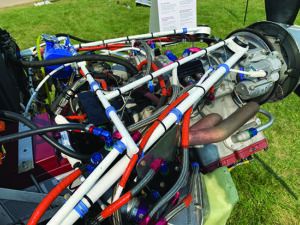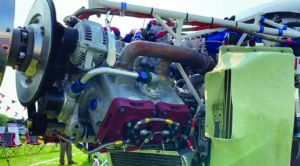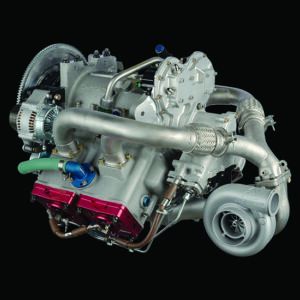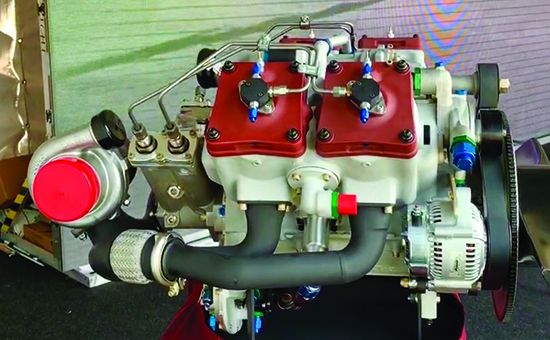The image of the Jet-A four-cylinder DeltaHawk engine below is from coverage I did at AirVenture in 2019, when the Wisconsin-based company was expecting FAA certification by the end of that year. Nearly four years later, DeltaHawk announced that the FAA has finally issued type certification for the DHK180A4—the first of a family of engines with varying power.
Yes, it took many years and a lot of money for the FAA TC, and while naysayers may have once written off DeltaHawk as a serious contender (at least in the GA engine market—there are plenty of other potential applications for this engine), it’s tough to argue that the certified and experimental markets are growing desperate for more engine choices.
With long delivery delays and eye-watering price increases for common piston engines, plus a growing demand for fresh and reliable engine tech, the timing may not be more favorable for DeltaHawk to make a go of its unique DHK180, and variants of it. The certification announcement comes not long after Rotax announced its new turbo 160-HP 916 iS model—an engine that I predict will eventually gain sizable traction.
At press time and days after the DHK180’s announcement, I talked with Dennis Webb, DeltaHawk’s director of marketing and certification (and an FAA DER), to find out what’s next for the engine.
TECH SPECS

Since the DHK180 is by FAA definition a “product” (as opposed to an “article”) an FAA type certificate is required just as it is for aircraft and propellers. The type certificate is what DeltaHawk needs to present the engine to OEMs for potential equipage in existing or new aircraft models. It’s also the first step in potential aftermarket retrofits, which will require STCs—not a trivial task. Neither is setting up a dealer network and building a training program for field support and installations.
As for the liquid-cooled, Jet-A-burning DHK180, don’t call it a diesel. The proper term in FAA engineering circles is compression ignition, as opposed to spark ignition. Equipped with mechanical fuel injection, it will keep running after a total electrical system failure.

The supercharged and turbocharged DHK180 weighs 357 pounds with the exhaust and turbo, and one of the primary selling points is the engine’s stone-simple simplicity. It has 40 percent fewer moving parts than a traditional GA four-cylinder engine, plus it’s designed for easier maintenance with the major accessories—including the cooler and oil pumps—externally mounted.
It’s single-lever controlled (via a mechanical throttle linkage—not FADEC computers), has push-button start and it’s directly driven to the propeller with no reduction gearbox. The company has been vibration-testing the engine (which has a damped and balanced crankshaft) with both Hartzell and MT composite propellers, and given the torque that a compression ignition produces, these are constant-speed three-blade models, though there may be more combinations once the engine is in service.
VALUE PROPOSITIONS
Simple upkeep is the goal and to that end there are no cams, lifters, valves or magnetos. Inside the engine’s crankcase is a crankshaft and four pistons with connecting rods—that’s about it. Operational simplicity is also a goal, with reliable cold-weather starts thanks to integral glow plugs. And for cold-weather ops, there’s an option for a built-in Tanis engine heating system.
The engine is said to make sizable amounts of low-end torque at lower power settings, plus the supercharger and turbocharger support a critical altitude of 17,500 feet. While many spark ignition engines may be problematic restarting at thin-air altitudes, during its testing DeltaHawk found that the DHK180 will easily relight while in the high teens.
“Not to say that something can’t go wrong with this engine, but the design is such that there really isn’t much to go wrong,” Webb told me. DeltaHawk is not projecting a TBO at this point, but says the engine has a rebuildable block.
As part of its marketing campaign, DeltaHawk is stressing a number of value propositions based on what it thinks the market needs in a new GA engine. Interestingly, many of these ideas date back to 2006—more proof that new engine development and FAA certification don’t happen overnight. Foolproof operation was always a goal.
With no mixture control, carb heat, prop control and magnetos, DeltaHawk sees its engine catering to the masses demanding just that—including easy starts. Without using a heater, Webb said the DeltaHawk will start at -20 degrees F. Hot starts? Compression engines light off quickly.
“As pilots we’re taught to baby our engines—paying crazy amounts of effort minding power settings, temperatures and shock cooling. That doesn’t come into play with this engine,” Webb pointed out. Because the engine is liquid cooled, the cabin heater works like it does in a vehicle—with little concern for CO poisoning.
With a lot more torque and fuel efficiency than a typical traditional engine, DeltaHawk puts performance high on the list of selling points. There’s also the widespread worldwide availability of Jet-A, while also focusing on SAF biofuels.
Front and center in DeltaHawk’s counterpoint to traditional turbocharged engines is reduced upkeep effort, lower costs and far better reliability, with an end goal to change the way the market thinks about turbocharged engines. Webb pointed out that buyers tend to shy away from turbos because of their finicky complexity. “In general, there aren’t a lot of turbocharged gas aircraft engines because they’re expensive, turbos and wastegates break and cylinders burn up—the list goes on,” he argued, pointing out that the DeltaHawk’s EGTs run at roughly 1200 degrees F in cruise, compared to higher temps on traditional turbos. Moreover, there’s no wastegate on the DeltaHawk because you can’t overboost the engine.
Webb said that unlike a FADEC-controlled engine, if a fuel pump fails on the DHK180, you’ll lose 25 percent of the engine’s power. I asked about turbocharger failures and Webb estimated it would reduce the engine’s power to around 40 percent of normal. Call the failure a controlled descent, I suppose.
FIELD RETROFITS

In retrofitting the DHK-series engine via a future STC process, you can expect a sizable amount of work simply because this engine is different than the Lycomings and Continentals it might replace. For some aircraft, the task will include modifying the engine cowling and definitely replacing the engine mounts. It’s possible that DeltaHawk will offer retrofit kits that include modified cowlings that will be sleeker than stock and provide more airflow to the engine.
It’s natural to ponder why the engine is designed with an inverted-V block, and the reason is that the crankshaft must align with the aircraft’s prop centerline. If the V was upright, it would cause a visibility issue over a high cowling. Webb told me the DHK180 fits nicely in place of a common 360-series engine.
I asked what aftermarket applications—and at what price—we might expect to see for the DeltaHawk. Who’s the typical buyer? Webb danced around the question, but I can’t argue with his assessment that if you fly a Skyhawk (as but one generic example) 50 or fewer hours per year, you probably won’t buy this engine. He definitely sees a market in high-performance experimental kitplanes. Aging Cirrus models, later-model Cessna Skylanes, Centurions, Mooneys and other higher-performance singles and twins are likely in DeltaHawk’s sights, too. There’s also an OEM focus. For certain, any new engine has to prove its reliability (and supportability)—and that’s part of the work that’s ahead for DeltaHawk.
As for price, it hasn’t been set, but DeltaHawk is targeting around $60,000 for the engine, not counting an engine package/installation kit and labor. Initial retrofits will be done at DeltaHawk’s Racine, Wisconsin, production facility. Stay tuned for an on-location field report and visit www.deltahawk.com.





